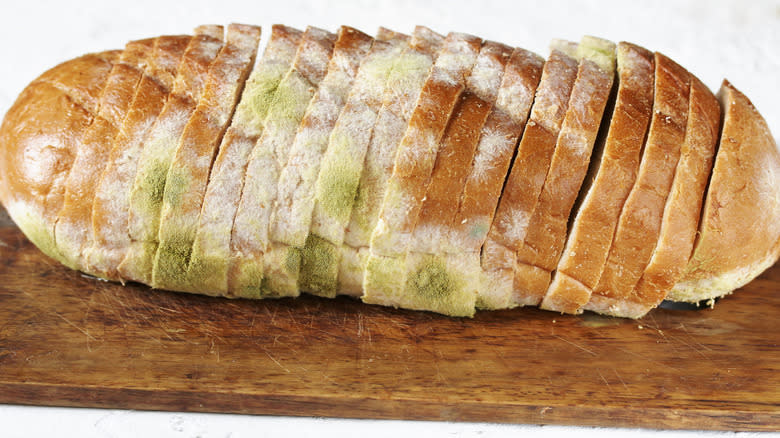When Buying Bread, Pay Attention To The Top Of The Loaf

When it comes to picking the perfect loaf of bread at the grocery store, most people focus on factors like freshness and texture. However, there's another crucial detail that often goes unnoticed -- the top of the bread. Some loaves are dusted with flour for that rustic, artisanal appearance, while others are not. The presence of white spots on top can sometimes be cause for concern, as it may indicate mold rather than flour. Here's how to distinguish between the two and ensure you're taking home the freshest bread possible.
Flour on bread usually has a matte, slightly powdery look, giving the loaf an inviting, rustic appearance. In contrast, mold often appears as irregular patches with a fuzzy, uneven texture. If the white spots look more like a dusting than a random growth, it's likely just flour. To be certain, carefully smell the bread. Fresh flour-dusted bread should have a neutral, wheaty scent. Mold, on the other hand, emits a musty, unpleasant odor that is quite distinct. Press the plastic over the white spots with your fingertip. If it's flour, it should be dry and powdery. Be cautious not to damage the loaf by pressing too firmly.
Read more: What Happens If You Accidentally Eat Mold?
How To Avoid Moldy Bread

To ensure that you do not head home with a moldy loaf of bread in tow, there are other steps you can take to choose a fresh loaf. Always start by inspecting the crust of the bread. If you see white spots that don't resemble flour and that show any signs of mold growth, it's best to choose a different loaf. If available, opt for bread from a local bakery, where you can ask for recommendations and the turnover is typically faster, ensuring a fresher product.
Sometimes, the bread's packaging can give you clues. If there's condensation inside the bag or visible mold on the packaging itself, it's a sign that the bread may not be fresh. Most commercial bread comes with a "sell by" or "best by" date. While this is not a guarantee of freshness, it can be a helpful reference point. By using your senses -- sight, smell, and touch -- you can confidently select a loaf that's not only appealing but also free from any unwanted surprises. So, the next time you're at the bakery or grocery store, give your bread a once-over to ensure you can enjoy delicious, mold-free sandwiches and toast.
Read the original article on Tasting Table.

 Yahoo Lifestyle
Yahoo Lifestyle 
